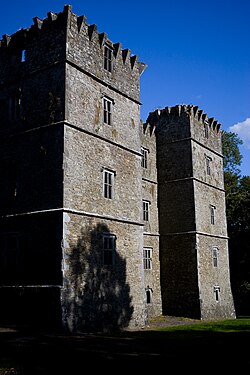Kanturk
|
Kanturk Ceann Toirc
|
|
|---|---|
| Town | |

Kanturk Castle
|
|
| Location in Ireland | |
| Coordinates: 52°10′30″N 8°54′0″W / 52.17500°N 8.90000°W | |
| Country | Ireland |
| Province | Munster |
| County | County Cork |
| Population (2011) | |
| • Total | 2,263 |
| Time zone | WET (UTC+0) |
| • Summer (DST) | IST (WEST) (UTC-1) |
| Website | Kanturk.ie |
Kanturk (Irish: Ceann Toirc, meaning "Boar's Head" - also the town's emblem) is a town in the north west of County Cork, Ireland. Kanturk is situated at the confluence of the rivers Allow and Dallow (also Dalua), streaming further on as tributaries into the Blackwater. It is about 50 kilometres (31 miles) from Cork, Blarney and Limerick, and lies just north off the main N72 road, 15 km (9 miles) from Mallow and about 40 km (25 miles) from Killarney.
It is a small market town, which after many years with a static population has commenced to grow again. Apart from its creamery which produced casein from milk, a raw material for early plastics, its former knitwear facility now produces concrete flooring products. The town's schools include Coláiste Treasa and Scoil Mhuire.
A historic site close to the town is Kanturk Castle, known locally as the Old Court, a fortified house built in 1601 for MacDonagh McCarthy as a defence against English settlers. It was a limestone rubble Tudor mansion four storeys high, 28 metres in length and 11 metres wide, with four towers of five storeys high and a height of 29 metres. According to legend, the castle was never completed as word of its construction reached the Privy Council in England. They ordered MacDonagh to stop building works, as they feared it would be used as a base to attack English settlers. Macdonogh was allegedly so furious at this news that he smashed all the blue ceramic tiles for the roof and threw them into a nearby stream. The stream then became known as the Bluepool Stream because of the reflection of the tiles in the water. Due to its architectural and historic importance, it is owned by An Taisce (National Trust for Ireland), and is a designated National Monument.
...
Wikipedia

